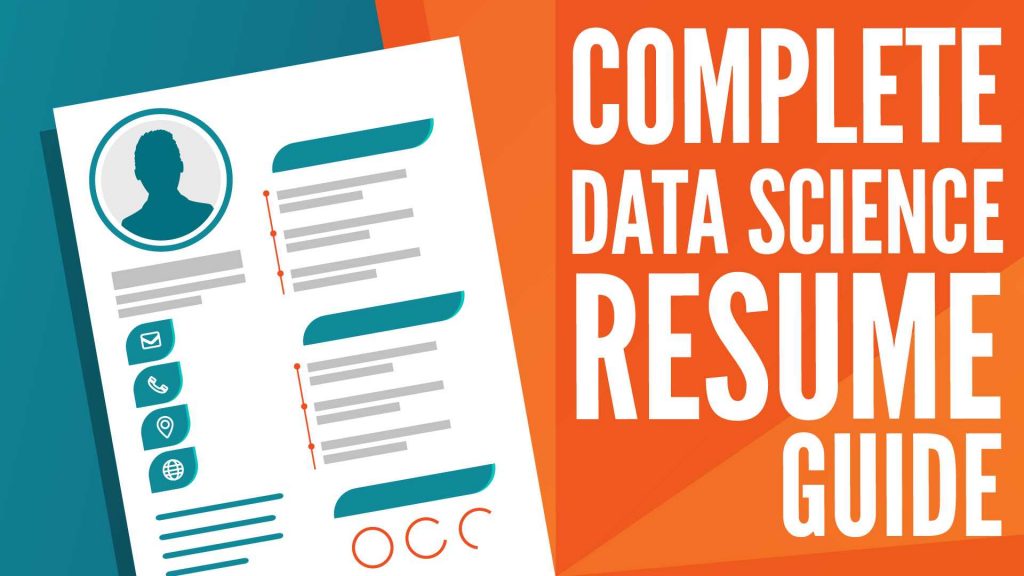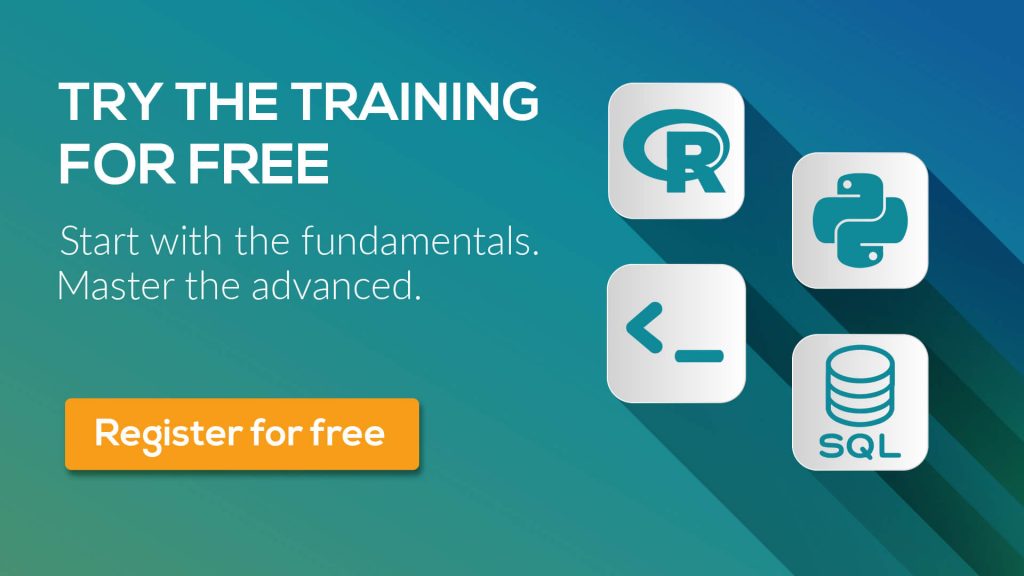https://365datascience.com/data-science-resume/ -

The data science resume has one major goal – to persuade the employer to invite you to an interview.
However, given that recruiters go through hundreds of resumes per day, this could be quite a challenging task.
In fact, large enterprises, such as Google, receive more than 50,000 applications in a single week! Not to mention that almost all prominent corporations, including up to 95% of the Fortune 500 companies, use an ATS (Applicant Tracking System). So, that’s one more barrier your resume needs to jump.
Taking all of this into account, as well as the soaring high interest in data science jobs, it’s clear you need to write a sharp-looking resume that’s easy to read and rich with content to land that data science job interview.
So, how to write a winning data science resume?
You’ll learn everything you need to know in this article. Here’s what it covers (you can jump to the section that interests you using the links in the contents below):
- the best resume writing practices to help you create an impressive data science resume that creates interest and convinces the company to call;
- how to write data science resumes if you are:
– an aspiring data scientist fresh out of college;
– a professional transitioning into data science from a completely different field;
– a seasoned data science expert looking for new career opportunities;
- the Do’s and Don’ts in a data science resume;
- a shortlist of the best resume builder websites and resources;
- bonus tips: What’s the difference between a resume and a data scientist CV; Is it necessary to use professional resume writing services; and How to build your digital presence.
Let’s get the ball rolling, shall we?
How to Put a Data Science Resume Together?
Whether you’re preparing a resume for data scientist or any other data science job out there, you should always follow the best resume writing practices. In other words, forget the generic resume.
A successful data science resume should be focused on the specific position and audience. That means you must target the specific company by using matching keywords with the skills and competencies listed in the job description.
Your resume must meet the exact needs of the employer and guarantee to them that you’re the data science professional with the right mindset, qualifications, and skills they’re looking for.
How to create an impressive data science resume that convinces the company to call?
Recruiters are looking for years of experience and specific data science related degree or concentration. But listing your key competencies early in the resume is not enough. You must also quote explicit numbers and details that add credibility to your accomplishments.
Once you’ve covered the essentials, you should fine-tune your data science resume to add a professional touch to it. That means using strong action words that demonstrate you are a doer and achiever…And don’t underestimate the power of consistent, pleasing to the eye format, and clean looks.
Anything else? Most definitely, make it brief.
Employers love a resume that makes a clear point and highlights the qualifications, skills, and experience they need.

In a nutshell, your data science resume must be tailored to a specific job posting, appealing, concise, easy to read and mistake-free.
Of course, there are different strategies to achieve that.
Sections, things to include in a resume, writing style, and format vary, depending on where you are on your data science career path.
That said, let’s see how you can put together a data science resume that hits all the requirements. The following section is dedicated to those of you who are new to data science:
- recent college graduates,
- or professionals who transition from another field.
After that, we’ll continue with some valuable insights for those of you have rich data science experience and want to move up the data science career ladder or switch employers.
How Do I Write a Great Data Science Resume with No Experience?
How to write a data science resume if you are fresh out of college?

In this part, we’ll focus on those of you who have just graduated from college or university, regardless of your major. So, how to make a resume for first job? Here’s all you need to know to craft a data science resume that will get you to the job interview for your first entry-level data science position.
Skill-based, chronological, or combined resume types?
- There are different types of resumes – skill-based, chronological, combined. And it’s up to you to choose the one that highlights your competencies in the best way possible.
- Skill-based resumes focus more on skill levels and achievements and less on work experience. (So, writing a resume with no work experience is not an impossible task after all).
- Chronological resumes are much more work experience-oriented. If you’re a recent graduate who doesn’t have much experience, a chronological junior data scientist resume will only bring attention to this weakness.
- Combination/hybrid resumes are the preferred type for young professionals and college students writing their first resume. It allows you to combine elements of both the chronological and functional formats. Its flexibility gives you a chance to display your data science resume content in the most effective way possible. If you’ve just graduated, a clever hybrid resume between your relevant skills and education will make up for the lack of long professional history in the field.
How to build a combination resume?
Here’s the first tip for building a data scientist entry level resume. Don’t get preoccupied with consistent formatting or particular details from the get-go. Just write down all relevant experiences that come to your mind – education, data science internships, job-specific skills you’ve acquired, data science projects for resume, dates, leadership positions. Once you list all the experiences on the page, you can start organizing them. List your skills and qualifications first. Then continue with any relevant employment history you might have or data science projects you’ve participated in (beginning with the current or most recent one).
Resume Sections – Parts of a Resume
Data science resume sections can be quite tricky for novice resume writers – is there even a way to escape from the limits of just education and lack of work experience? Of course, there is. Think of your data science entry level resume as a chameleon-like document that changes nuances depending on the job you’re applying for. For example, the astrophysics club may not be relevant to the data analyst position in a financial corporation. However, it could be a great asset for a software engineer job.
Resume Headline/Resume Titles
This is where you put your name and the job title of the position you’re applying for. Always customize the job title for the desired job. This will immediately signal your potential employer that you have the skills and qualifications to match their requirements.
Profile Summary vs Data Science Resume Objective
Data scientist resumes can contain either an objective or a data scientist profile summary section. These are optional, so if you decide to include one or the other, make sure it’s worth the space. This means they should target the specific company and position, mirror the language of the job posting, and be aligned with the needs of the data science employer. This is valid even if you’re writing a data science internship resume.
That said, as a recent graduate just entering the data science field, you’ll benefit most from an objective statement. It shouldn’t be longer than 3-4 sentences. Include a strong quality, your skills, and the name of the position and the company you apply for. Most importantly – conclude with benefits you’ll bring to the employer.
Objective Statement Examples:
- Result-oriented individual with strong capacity for learning and Bachelor’s in Computer Science. Seeking to utilize hands-on modeling experience as an Entry Level data scientist at BCG Gamma. Coming with expert knowledge of scripting languages and ability to work in a cross-functional environment.
- Highly analytical Economics graduate with strong interpersonal and leadership skills. Looking to apply superior analytics skills as a Data Analyst at IBM. Coming with solid statistics background, programming skills, and ability to clearly communicate complex and industry-specific concepts.
- Team player with strong communication skills and certificate degree in Data Science. Seeking to leverage on model development experience and strong understanding of research design and hypothesis testing as a Data Scientist at Appsilon Data Science. Coming with programming skills and ability to analyze complex data.
Contact information
Contact information should be at the top of the page on your resume, right below the job title with your targeted position and your objective statement.
It comprises your full name, your phone number, and a professional email address. Avoid including any kind of personal information, such as physical traits, race, ethnicity, citizenship, date of birth, marital status or Social Security number.
You can also add your website, LinkedIn, GitHub and Kaggle data scientist profile, or any other platform that demonstrates your data science adeptness.
Education – How to List Education on Resume?
For an aspiring data science professional who just finished college, it makes perfect sense that your education section of resume is higher up. In fact, it fits great right below the contact information and/or the objective section.
State the name of the college or university, city, and state, degree (Bachelor of Arts, Master of Science, etc.). Make sure you include your major(s), and minor(s), the year and month you completed your degree (or expected date of completion). If you have more than one degree, list the highest or most relevant first. U.S. graduates can also include their GPA score (but that’s optional).

Data Science Projects and Publications
This is the section where you can make up for the absence of rich professional experience. So, how to include project details in resume? Data science related course work and academic projects work great for graduates with relevant background. You can even include links to your Github projects. This way, potential employers will be able to see what you’ve created and how you’ve done it. However, if you have a background in psychology, a more prominent leadership section or a stronger role in a student club could be a better choice. In short, one resume doesn’t fit all. But that gives you the freedom to leave out some sections and add others, depending on the data science job you apply for.
Experience – How to Write a Resume for a Job with No Experience?
If you feel anxious about this section, don’t. Actually, it gives you a great opportunity to align your past experiences in a way that matches your data science career pursuits. You can include relevant full-time, or part-time placements, student teaching, internships, practical classes, academic research, and even volunteer work. Instead of Work Experience, you can choose alternative headings for the different categories that best represent your experiences, such as Professional Experience, Professional Affiliations, Relevant Experience, or Research Experience. Remember to list the most relevant experience first. Other important things to write in, are the name and location of the company/organization, your position title, and period of employment. Each should have two to five bullet points demonstrating how you applied your skills to an assignment or a project.
Skills – How to List Skills on a Resume?
This is the most important part of your data science resume. So how do you make it stand out without years of data science expertise behind your back? The answer is: transferrable skills. In fact, that’s exactly what employers are searching for in entry-level data science positions for fresh-out-of-college applicants.
Transferrable skills indicate that you have mastered a certain skill in your previous experience, and you can apply it in a way that brings value to your future employer.
You have already developed many of these skills in your internship experience. Or while working on an academic project. Those can include:
- strong eye for detail;
- ability to understand business needs and convert them into clear technical requirements;
- understanding issues and using effective approaches for developing appropriate solutions;
- ability to clearly articulate and confidently present findings and technical details to executives and a non-technical audience;
- self-starter able to pick up ways of working quickly;
- able to plan, organize and manage multiple projects with competing demands and deadlines;
- work as a team player, interacting with employees of all levels of the organization, etc.
Just make sure you illustrate how you applied each of the above in practice.
Leadership
A lot of data science positions require leadership as a quality. Therefore, if you have the right experience, a more notable leadership section might make up for insufficient quantitative background. To craft an attractive leadership section, add the organization name, the positions you were appointed, dates, projects, prominent contributions, as well as the skills and capabilities you’ve demonstrated. Of course, this section in your data science resume should be formatted with bullet points, just like the experience section.
Honors and awards
Honors and awards can also be a stand-alone section on your data science resume. List the name of each honor or award, and the date you received it. A brief description emphasizing your accomplishment is optional.
Certificates – How to List Certifications on Resume?
Listing data science certificates can only benefit your resume. On one hand, they signal the employer that you’re qualified for the data science position, even if you don’t have the most suitable background. On the other hand, certificates demonstrate ambition and commitment to developing industry-relevant and in-demand data science skills. It’s good practice to update your resume with newly-acquired certificates. Moreover, it’s a good idea to consider signing up for advanced specialized data science courses and upgrade your skillset with the specific position in mind.
Activities resume and community involvement (Optional)
Here you can showcase your participation in various on- and off-campus communities. To make your contributions stand out, it’s best to organize this section in a list format. Include the positions you’ve been appointed to, the organization names, locations, and dates. In addition, you can highlight a study abroad program you’ve been enrolled in, as well as some prominent volunteer experience.
Interests (Optional)
“Interests” is a non-obligatory section. However, many employers would like to know a little bit more about you, outside your education and job-related experience. If you decide to list your interests or a talents list, try to be specific and genuine.
Data Science Resume Writing Style – How to Write a Resume for the First Time?
To write a noteworthy resume, there are a few style guidelines you must follow.
First, keep in mind that your data science resume is often your first introduction to a prospective employer. That means you should take your time to make it visually attractive, and free of typos or grammatical errors.
Second, aim to be brief. 15–30 seconds of consideration is all that your resume may get.
Include only information that is relevant to the data science position and underscores your qualifications. Don’t overload your resume.
That said, resume language should be:
- straight-to-the point rather than general;
- active rather than passive;
- written to convey your relevant data science qualifications and skills, not to impress;
- clear rather than elaborate;
- factual, both in terms of quantifying and qualifying your accomplishments;
- written for speed-readers.
How can you achieve that? By using powerful verbs. Here’s a list of action verbs you can refer to once you start writing your resume for data scientist.
Now you know how to write a one-of-a-kind data science resume, so let’s see how you can format it to stand out.
How to format your data science resume?
After spending long precious hours in developing your data science resume content, the last thing you want is to risk it ending up in the “maybe later” pile. So, what should a resume look like? Your resume won’t go unnoticed, if you make sure it’s appealing and has accurate spacing, and that all the information is delivered consistently, in a neat one-page or two-page package.
We understand It is rather difficult to choose the format of your data science resume.
Some candidates use standard one-page templates, which are well organized and structured. The slight setback is that 90% of people use these templates.
This doesn’t mean they aren’t good, but it raises the question of whether submitting a resume that is like everybody else’s makes you stand out.
There is another option too – using a resume that contains more formatting and goes slightly beyond Microsoft Word’s basic capabilities. No matter which way you decide to go, you should always aim to have a resume that looks professional and well organized. You can opt for a data scientist resume format that contains few formatting elements or choose a format style that is a bit more appealing to the eye and makes an immediate impression. In any case, always consider the type of job that you are applying for and avoid going overboard with flashy resume design and intricate elements. Here are a few more tips on formatting your data science resume.
Resume Headers
Section headings should be left-aligned and prominent but under no circumstances distracting. You can bold or capitalize the headings in your data science resume, use italics, or underline them. These help break up the length of the document and create emphasis. Remember to stay consistent – bold for the organizations you’ve worked for, italics for the job titles, and so on.
Font
Ideally, it’s best to choose resume font size somewhere between 10.5 and 12. The only part that should be larger on your data science resume is your name at the top. So, if your text is size 12, you can go for 14 or 16. Choose a font that’s easy to read both on-screen and off-screen There are more than enough possibilities. Font face shouldn’t be distracting. It’s a means to deliver your message, not part of it.
Resume Length – How Many Pages Should a Resume Be?
A 1-page resume should be enough for most recent graduates or young professionals. Should a resume be one page without exception? Of course not. If you already have a significant amount of relevant experience or advanced degrees, you may need 2 pages.
Layout
The layout of your data science resume should make it easy to scan. Also, provide some spacing to ensure it is aesthetically pleasing.
Should you include a photo in your data science resume?
Depending on the country and its anti-discrimination policy, including a photograph in the resume of a data scientist might be either acceptable and even required or completely undesirable.
That said, don’t include a resume photo in the United Kingdom, Ireland, and the U.S.
On the other hand, it is recommended that you have a resume photo if you’re applying for a data science job in one of the following European countries: Austria, Belgium, France, Germany, Portugal, Spain, Scandinavian Countries. The same applies to the Middle East, Africa, Asia, and South America.
How to write a data science resume if you’re transferring from an unrelated field?

As an experienced professional, you’ve already sent a decent number of resumes throughout your career.
However, if your work history has nothing to do with data science but you’re willing to transfer into the field, you should consider adjusting your approach to your circumstances.
What’s the best resume choice – skill-based, chronological, or combined data science resume?
If you are switching to data science from a different industry, a chronological resume will make you look like you’re the wrong person for the job. In your case, a skill-based or a combined resume is the one you should choose.
I’d even take my recommendation a step further and encourage you to go for the data science skills resume.
Why?
Because skills-based data science resumes are designed to help professionals like you, namely, those who don’t have the relevant work experience. Here’s what’s typical of this resume format:
- extensive objective statement;
- more detailed skills section of resume, emphasizing the skills required for the targeted position.
Furthermore, a skills-based data science resume diverts the spotlight from work history and education, which is likely a good strategy in your case.
Now that we’ve covered the basic resume outline, let’s go over the resume sections you should pay special attention to.
Sections of a Resume:
Resume Title/Headline for Resume
Your headline must be a role match. Write a target job title that’s identical to the title in the job description. This will not only grab the attention of the hiring manager but will also prompt the ATS (Applicant Tracking System) to score a match between your resume and the job posting.
Contact Information
This one is straightforward – name, phone number, professional email address, along with links to your LinkedIn, Github, and/or Kaggle profile.
Data Scientist Resume Objective
A winning data science resume for someone trying to make it in data science from a different field should revolve around the needs of the potential employer. And you should make that your priority, starting as early as the objective statement.
How can you achieve that?
It’s quite simple – use the mirroring technique. Include specific keyphrases and align your skills and data science career goals with the company’s goals and needs. You can find what these are in the company’s mission statement оn their website.
The objective must also convey enthusiasm and target the specific data science position. It should show that you are a loyal individual who is determined to contribute to company success. So, write your objective statement that tells the hiring manager at a glance how you’ll bring value to the organization.
Skills – How to Write Skills on Resume?
This is possibly the most important section in your data science resume.
So, to make it work in your favor, first, you need to determine the relevant skills for the position.
The first thing to consider is that job postings include specific keywords for the top skills employers look for. And, unfortunately, it’s highly likely that your resume will be rejected if it doesn’t contain these keywords. As we mentioned above, many employers use ATS (Applicant Tracking System) that scans resumes for keywords and automatically eliminates the ones who lack those. Of course, you can avoid that by identifying the most important keywords and including them in your data science resume.
To do that, you must think about the needs of the hiring company from the very start.
All required skills are already communicated in the job posting. All you need to do is decipher it.
It’s true that most companies are listing the necessary skills in a straightforward way. However, they can sometimes be represented as characteristics, competencies, job responsibilities, or even duties. So, don’t skip these.
- Carefully evaluate your level of expertise in each skill for your targeted data science position. Think of the top 3-5 essential skills for the position and list them in your resume skills section. Then, provide relevant, quantifiable evidence for each skill using bullet points. Quantify experiences to convey the size and/or scale of projects, budgets, and results. This makes a stronger impression.Include instances where you:
- Established new strategies or procedures;
- Used resources effectively (e.g. in a way that reduced expenses);
- Produced ideas that were successfully adopted or you implemented yourself;
- Demonstrated effective project leadership or management;
- Managed or supervised others efficiently.
- Received promotions or expanded your scope of responsibilities.
- Raised the profits or improved the services of a company.
- Achieved a specific result.
- Resolved an issue.
- Earned recognition from others…
And be prepared to answer ‘How?’ And ‘Why?’ follow-up questions for a lot of these achievements.
Basically, you have to create a narrative about yourself. And the type of story you want to tell isn’t one where you erase your past. It’s one where you distinguish yourself by leverage your domain knowledge and highlighting relevant accomplishments and skills.
Besides the list of technical skills, make sure to also include interpersonal skills that suit the company culture.
Choose transferrable skills that show you’ve got what it takes to do the job thanks to the capabilities you’ve developed throughout your career.
Forget the age-old clichés like “trustworthy”, “dynamic”, “problem-solver”, “great communicator”. Throwing them out there will make them seem devoid of meaning, unless you also write how you’ve demonstrated those skills and how they apply to your professional competence. Always remember that organizations are goal-oriented. Therefore, you need qualities and skills that translate easily across various industries and contexts. Taking initiative, and pursuing challenging goals are some good examples. So are “ability to adapt”, “learn from experience”, “initiate positive changes”, “flexibility”, “independence”, “self-direction”, and “accountability”.
Use your qualifications to show what value you can provide.
“if you’ve already done some finance, leverage your knowledge in finance. Don’t erase your past.”, says Edouard Harris, a physicist turned successful data scientist and co-founder of SharpestMinds, “Don’t be like, Oh, I was in finance but not anymore. No, no, no. You want to be like, Yeah, I was in finance. I was goddamn good at it and I worked on x, y, and z when I was in finance. And now, look at how I’m applying x, y, and z in interesting and clever ways as appointed to this instance. Essentially, you want to tell a story and also create a narrative about yourself. And the narrative you create about yourself when you transition is not, Oh, I’m changing everything about myself. It’s more like, No. I’m moving away to even further increase the value of the experience that I already have.”
Publications (books, articles, white papers, etc.), seminars you’ve attended (or you’ve given) can also be relevant.

Work Experience
Make this section as brief as possible, listing dates, job title for each position you’ve held, company names, and locations. Of course, any working relations within the specific industry of your potential employer can be a plus point.
Relevant Certificates/Education on Resume
The competition for data science positions is intense. That’s why you need at least one certificate that proves you’ve got the necessary skills for the job. However, going back to school to earn a relevant degree could be quite challenging for a working professional, even if you’re in-between jobs. Fortunately, there are alternative ways to learn data science at your own pace. For example, by enrolling in all-around online certificate trainings, you can not only cover the fundamentals but also have the chance to upgrade your data science skillset with advanced specialized courses. Some programs (like ours) also comprise real-world data science projects you can include in your portfolio, along with professional data science resume feedback.
Data Science Projects and Publications (if applicable)
Next, you should highlight your accomplishments and any data science projects you may have participated in. This is where you can be specific about the projects, the tools you have used, and the goals you’ve accomplished. But don’t overcrowd the section with technical terms. After all, the general idea should be accessible to hiring managers with a non-technical background.
Also, strive to make the projects section brief but rich in content. Hiring managers view past achievements as an indicator of future ones. Therefore, the smartest thing to do is to use them as a trigger to get an interview invitation. So, as far as your data science resume goes, you should be able to communicate in a bullet point the situation, task, action, and result that demonstrates you have met an important objective and have the qualities to replicate your success in the future. Once you get to the interview, you’ll have the chance to talk in more detail about what you’ve accomplished.
Of course, you should also add your background education and degrees in this section (not as prominently as you would if you were holding a Master’s in Computer Science, for example; but your degrees still demonstrate your value, no matter what your major was).
Leadership
If you haven’t been in a leadership position, you can list self-directed projects or examples of autonomous group work. Those demonstrate leadership skills, as well. In addition, such initiatives indicate a high level of responsibility and commitment to your colleagues and the enterprise as a whole.
Honors and awards
Should you include honors and awards on your data science resume? Yes, but only if the accomplishments are relevant for the position or if they highlight skills that are invaluable to the employer. For example, include “Winner of Tech’s excellence award for Technology Innovation of 2019 – team collaboration” because it points out you’ve implemented your expert skills in a cutting-edge product; don’t include awards from elementary school or high-school. Reminiscing about the past is endearing. However, you should stick to recent achievements corresponding to the position you’re after.
What resume language should you use?
To create an impactful resume, you must polish it with dynamic, action-packed words. Here’s an example:
“Managed” is a great power word. Don’t use “responsible for”. It fails to show how involved you were in the task or project, and it deprives you of any credit. And wouldn’t you prefer to hire someone who managed a team over someone who was responsible for them? Moreover, the verb “managed” conveys that you possess leadership skills. But simply using the magic word is not enough. You need to be specific. Telling the employer that you managed a big department means nothing. But “managed a department of 150 people” shows the exact scope of your responsibility. If you want to emphasize how profitable your department was, quote precise numbers. For instance, “increased profits by 47%”. This demonstrates that your leadership results in profit growth, and you get well-deserved credit for that.
How to combine power words in your data science resume for great impact?
Using action words in this order will help you supercharge your resume. However, use word like “developed”, “managed”, and “implemented” in moderation. After all, not everything you’ve done can be described with powerful words. And the last thing you want for your resume is to sound unnatural. In any case, following this advice alone isn’t enough to polish your resume writing style. You must also avoid vague, cliché words, such as “having great communication skills” or “a great team player”. Such generalizations not only lack any evidence but also fail to spark interest. Instead, impress the hiring manager by bringing out your strengths with vivid and specific language.
Last but not least, remember the first rule of all resumes – anything you put on a resume is fair play to be inquired about. So, you should feel confident talking about all the things included in your data science resume.
How to write a data science resume if you have experience in the data science field?

So, you’re a data science professional who wants to change career tracks (e.g. from data analyst to data scientist)? Here’s the first thing you should consider before you shape your data science resume.
It makes a difference if your goal is to start a job at a new company or if you’re changing positions in your current one.
With that in mind, if you want to switch data science careers at your current workplace, it’s crucial to put the spotlight on all your contributions up to present.
Emphasize your achievements, the issues you’ve resolved, and the projects you’ve participated in. This is important, especially if you’re seeking promotion in your present organization.
The main objective of internal resumes is to show how your work positively affected an increase in sales, ROI, etc. A perfect time to present an updated resume will be at your annual performance review. If you’ve dedicated time to provide measurable proof of a profitable year, you’re in a great position to ask for a promotion, payment increase, or a bonus.
If you’re aiming to land a data science job at a new company, highlight the progress you’ve made since the beginning of your career and what inspired that growth.
This will help you determine the best way to organize and highlight your skills. Remember, a resume is a marketing tool. And you can use it effectively to bring your manager’s attention to your progressive growth.
In both cases, a well-crafted accomplishment statement that communicates your competencies will spike the reviewer’s interest. Don’t forget it’s essential to include quantitative evidence of your achievements. Thus, you’ll illustrate your value to your future employer. For instance, how many people were impacted, by what percentage you exceeded the goals, and how much revenue you helped generate.
Finally, include the role of your accomplishments in advancing the business goals of the company. Doing so will also aid your interview strategy. During the data science interview, the interviewer may ask you to elaborate on the accomplishments you’ve listed. Therefore, you have to be prepared to outline the problem, explain the actions in detail, specify the outcomes, and convey your value to your potential employer.
Why choose a skill-based or chronological resume format?
As a professional with extensive experience, it’s best to choose either the chronological or the skill-based format for your advanced resume.
The chronological format is suitable if your career has moved into a steady linear progression.
That is if you have consistently moved to higher positions in the same field without long periods of unemployment.
The chronological data science resume is the perfect fit for more traditional companies. It’s just what they are most accustomed to. It shows the employer that you are groomed for the position. That said, this resume format a great choice if you’re aiming at a promotion… or the next step up the data science career ladder.
There is also another option – the skill-based data science resume format
The skill-based data science resume is for those of you who have extensive experience and qualifications in the data science field. This format makes your unique qualifications stand out. For example, if you’re a senior data scientist who has been working in the same industry for 15 years or more, it’s hard to go any higher. Practically, the only job you can apply for, is the same position, in another company. So, to boast your extensive background, follow up the summary section with a rich bulleted list of key competencies. This is the format that allows you to bring the hiring manager’s attention to your exceptionally strong qualifications.

Sections (applies to both chronological and skill-based data science resumes):
Header Section, Contact Information, and Summary
Of course, you start with your resume header section, including your contact information and target job title. If you are a seasoned data science professional, opt for a summary section instead of an objective statement.
Here’s why.
A data scientist resume summary lets you bind together your experience with a common theme. In other words, it allows you to brand your expertise.
So, how to write a resume summary?
To write a first-class skills summary, use the keywords that the hiring manager is seeking. This will also make your data science resume ATS (Applicant Tracking System) friendly. To craft an outstanding data scientist summary, it’s important to know exactly what competencies to emphasize. Identify the skills you most enjoy using, the achievements that best demonstrate your capabilities, and the areas you are most enthusiastic to work in.
Then you need to analyze your target industry.
Once you’ve researched the industry, align your skills with the priorities of the hiring company and the most valuable skills for your target position.
Finally, make sure every word is worth reading.
Identify your key selling points and tie them to the company issues you’re qualified to solve. Find the point where your goals meet your target organization’s needs and make it work to your advantage.
Skills
A vital section in your resume. This is where you let your expert skill set shine. If you’ve decided on a skill-based resume, format each skill as a subheading followed by a bulleted list of accomplishments supporting the skill you’ve mentioned.
Work Experience/Track record of achievements
If you opt for the chronological data science resume format, following the summary and your key competencies, you should have resume job description in detail. Starting with your most recent job. You can list accomplishments under each position using the same skill-focused approach as above. Or include a “track record of achievements” section. The latter is an effective way to underscore your measurable success across a long-standing career in an easy-to-scan manner.
Honors and Awards
Relevant honors and awards support your resume. And they can also give you the extra edge your resume needs to stand out. Include academic awards, as well as honor societies on your data science resume. It’s an excellent way to demonstrate that your work and contributions to the data science field have been recognized.
Trainings/Certifications on Resume
Your data science resume will certainly benefit from role- and industry-specific trainings, along with seminars or conferences you’ve attended. Data science is a rapidly changing field. So, verifying that you have the most up to date training is crucial.
Interests – What Interests to Put on a Resume?
The “Interests” section on your resume is more powerful than many people think.
Listing activities that show leadership and intellectual qualities implies that you have a well-rounded personality.
To avoid a generic “Interest section”, think of something that separates you from the rest. If you played any sports, whether individually or in a team, definitely add that to your interests. Being trained in a given sport conveys that you are outgoing, consistent, and disciplined. Plus, if your interviewer played that same sport, it will instantly create a connection. After all, people tend to like people with the same interests as them. In fact, C-level executives don’t just want someone who fits the basic requirements. They’ll strongly prefer someone interesting to spend time around with. That said, if you follow this simple principle, you could end up well above the other candidates for the job.

How to improve your resume writing style?
When it comes to resume writing style, less is certainly more.
Try to eliminate words like “numerous”, “approximately”, or “around” and use specific numbers and instead. But make sure you round up those numbers and percentages. Remove any redundant pronouns and articles. They only make your resume heavy without contributing to its content.
Overall, your resume should be sharp and precise, just like you.
Format – how to make your resume stand out?
Use simple, elegant fonts. Nothing extravagant. Contrast large resume headings with neat white space. Simplicity sends the message of professionalism and confidence.
What are the dos and don’ts in a data science resume?
No matter how experienced you may be in resume writing, there are certain pitfalls you should be aware of at all times.
Here’s a shortlist of recommendations and mistakes to avoid you can use at any stage of your resume writing process.
[table id=5 /]
Bonus tips:
Why choose a Resume over a Data Science CV?
To answer that question, let’s first identify the main differences between a resume and a CV (Curriculum Vitae).
- As you know, resumes are brief, provide an overview of your skills and experience, and are tailored to a specific job posting.
- CVs, on the other hand, serve a different purpose – essentially, they are much more detailed (and lengthy) documents used specifically for academic applications (the US and Canada).
Outside of the US and Canada (Europe, including UK and Ireland), a CV for data scientist and a Resume are interchangeable terms, both describing a short document targeting a certain job.
So, a job applicant, it makes perfect sense for you to follow the guidelines for writing a resume. Unless, of course, you’re applying for an academic position in North America.
Should you use professional resume writing services?
You should know that there is an alternative way you can choose when you have to write your resume. In fact, some people with less experience prefer to adopt this approach.
You can always hire a professional firm online that will write your resume. Fees may vary from $50$ to $250, depending on the type and the quality of service that you need. You’ll have to submit the relevant information about yourself and the firm will deliver a resume. You should carry out detailed research on the internet, as you have to pick the right firm that can provide a quality service.
Here are the Pros of using professional services:
- The format of your resume is going to be professional.
- You don’t have to worry too much about typos and proofreading (if the firm is a good one).
- The people who wrote your resume know how to structure the information they receive.
But there are some downsides as well:
- You and only you can tell the best story about you.
- You’ll be reluctant to modify the resume for different job applications, but you need to do that.
- At the end of the day, resume writing can be a rather expensive service.
Once I received a resume, for which I paid 50 pounds. It had a good format but was too cluttered and full of information. I had 0% success with it.
So even when you pay for resume writing services, you risk ending up with a bad product.
Resume writing companies offer an additional service, which can be a way in between writing your resume alone and hiring a professional to do it for you. You can still write your own resume, applying the principles that we learned here, and then once you are ready, you can submit it for “review” to a professional firm. It is much cheaper, and you will receive notes with areas that they think you should improve. You will be the one deciding whether or not to go through with the suggested corrections.
What are the best resume builder websites and resources?
There’s a pretty wide choice of resume builders available online. But how do you pick the best out of many? To make your search easier, we’ve made a quick list of the resume builders that offer the best features and useful relevant resources.
How to build your digital presence?

How to Optimize Your LinkedIn Profile?
LinkedIn is one of the go-to platforms if you want to establish a professional online presence. It’s one of the most popular tools for networking, searching for data science jobs and internships, and developing your data science career.
As a rule of thumb, finding and following companies you’re interested in will allow you to learn more details about them, stay updated on their news and explore the career opportunities they offer. It’s also a great way to get noticed by a recruiter from that organization. LinkedIn provides an indicator of how thorough your profile is. However, there’s room for improvement even in profiles that are 100% percent complete. That being said, below you’ll find some essential tips on how to improve your LinkedIn Profile in order to appear in more searches.
Professional Headline
First, make your headline brief and memorable by highlighting your skills and achievements with strong, impactful words.
In case you haven’t done it yet, customize your URL using your name or an abbreviated version of it. This will make it look visually pleasing on your data science résumé, and easier to share with others.
Photo
Choose a high-quality photo of yourself in business attire. You should be alone in your photo. Make sure there’s no obvious cropping and avoid backgrounds that distract the attention.
Summary
Your resume summary should expand the information in your headline. Structure it as a brief narrative in first person (6 to 8 lines) describing who you are and what you do. Include your education, relevant experience, competencies, and goals. Listing your contact information is very important if you want to be easily approached by recruiters.
Experience
This is where you put all relevant details to your qualifications, such as companies, job titles, dates, and locations. As mentioned above, make your impact and results measurable by quantifying your achievements wherever possible.
Education
Recruiters frequently try to find candidates by university, major, and graduation year. That’s why it’s important to provide all your resume education details, such as colleges/universities attended, majors, minors, certificates, job-relevant courses, study abroad programs, and internships. Good news is, you already have these in your resume education section.
Should you include your Github page on your data science resume?
Absolutely. A Github profile clearly demonstrates that you’re a qualified data science professional.
In fact, according to a hiring manager of data engineers, if you’re happy with the code, then it’s always a good idea to publish it.
Your project doesn’t have to be extraordinary to make its way to your data science resume. Because what’s valuable to a potential employer when browsing through your code is to get a sense of:
- your internal motivation to work on and publish side projects;
- the code you’re writing and whether it follows most best practices. (Everyone prefers to hire a specialist on their team, who already knows how to write “good, clean, and well-tested code” as opposed to having to teach them.)
In short, “If you’re proud of it, include the link!”
Should you include Kaggle competitions on your resume?
Now, participating in Kaggle competitions doesn’t automatically turn you into an expert. Nevertheless, it broadens your experience and enhances your data science resume. And that could certainly increase your chances of success.
On a final note…
While it requires a decent amount of preparation and work, writing a data science resume is in a lot of ways a creative task.
It allows you to take a step back and view your experiences from a different angle.
You get to reflect on how a hiring manager would perceive your qualifications and accomplishments with a specific job-role in mind.
Then you go through the curious process of highlighting your strong points and leaving what’s irrelevant in the background.
Finally, formatting gives you a chance to put the finishing touches and “frame” your resume in an elegant and impactful way. At the same time, your resume is a living and breathing piece that you get to revisit and adjust to each job position you’re pursuing.
This way, it remains a work in progress you can always develop, modify, and improve.
That being said, this shouldn’t stop you from taking a step forward and exploring the next steps in your data science career journey.
So, if you’re eager to discover what data science interview questions might be in the cards for you, check out our complete guide Data Science Interview Questions and Answers You Need to Know in 2020.
And, if reading this piece helped you identify some key data science competencies you still need to add to your skill set, take a look at the courses in the 365 Data Science Training. You can explore the full syllabus, or join the Free Preview Version of the Program to see if it’s the right fit for you.
#Career, #ProTips, #Resume, #Tips
#365datascience #DataScience #data #science #365datascience #BigData #tutorial #infographic #career #salary #education #howto #scientist #engineer #course #engineer #MachineLearning #machine #learning #certificate #udemy

No comments:
Post a Comment